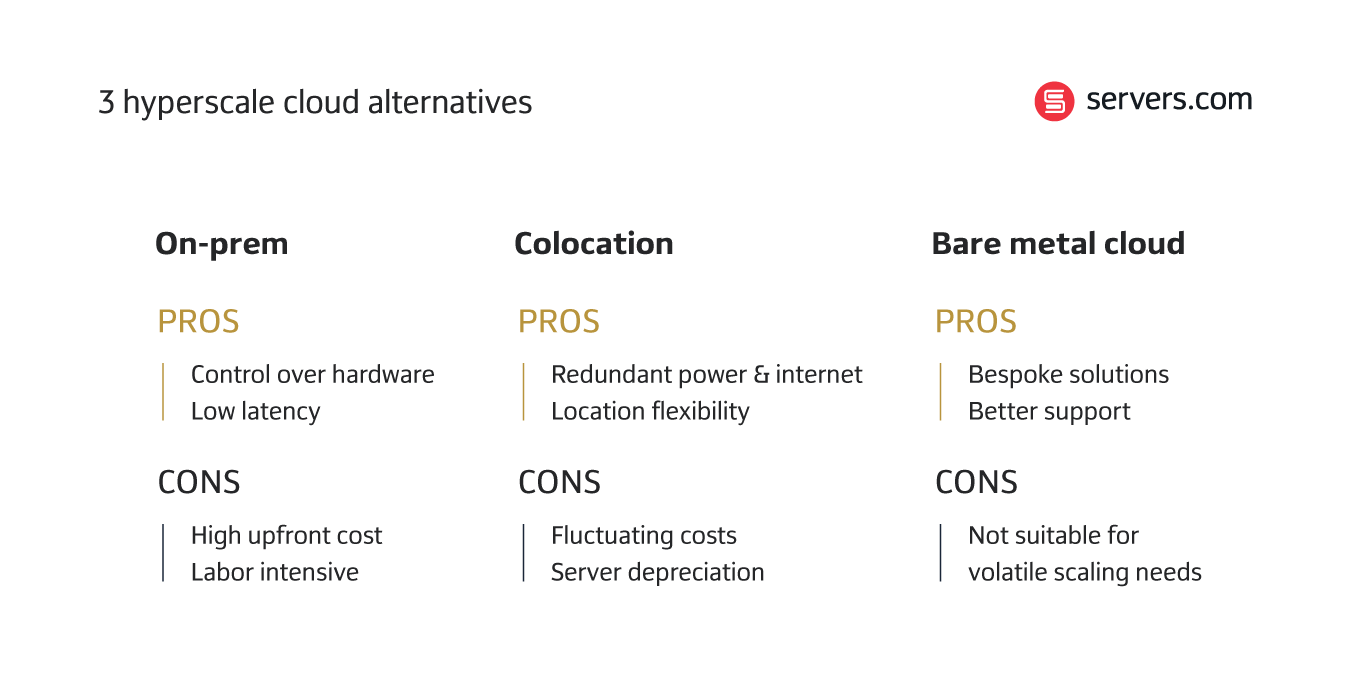

It started slow, but the ‘cloud exit’ conversation is now in full swing.
You might’ve already heard about David Heinemeier Hansson’s public cloud exit, documented over a series of blogs.
He was one of the first CTOs to talk publicly about the challenges and shortcomings of ‘all-in’ hyperscale cloud strategies.
And just a few months on, it’s very clear that he’s not alone.
People are starting to speak out on public cloud-first strategies.
People like Daniel Tremayne-Pitter, founder and CEO of strategic technology consultancy Dark Matter, who told us:
“The implications of the awakening from the cloud-first era are evident for many. The need to urgently revise strategies considering increasing costs and lack of control is palpable. I am in no doubt, after hundreds of interviews, that ‘cloud exit’ (be that in full or in part) is a pressing conversation that is demanding attention”.
When it comes to cloud computing, attitudes are changing, with CTOs and CIOs starting to question whether that ‘all-in’ approach was the best decision after all.
But why? And what hyperscale cloud alternatives are out there?
Back in the early 2010s, mass hyperscale cloud adoption was being fueled by the perceived cost benefit of shifting from a CAPEX to an OPEX model. Riding the wave of cloud marketing, and in search of viable on-prem and colocation exit options, many businesses moved their workloads from on-prem data centers straight into cloud.
Lift and shift. Zero refactoring.
So, what happened? Well, as AI and Cloud Computing expert David Linthicum talks about in his recent video, “a very inefficient application on-premises became a very inefficient application in the cloud and ended up costing a lot of money”.
“Because the cloud is a utility. Very much like if you leave your electronics on in your house, you’re going to get a big bill from your electric company”.
In other words, for a lot of businesses, the cost benefit of cloud never materialized. So, naturally, they’re starting to consider cloud exit strategies.
But it’s not just the misalignment between an expectation of cloud and the reality of what it ultimately delivered that’s at play here. As new technologies enter the scene, infrastructure requirements are changing just as fast. Daniel furthers:
“As we enter the new epoch of AI – organisations are going to need robust infrastructure foundations and a different set of behaviours to build better outcomes. If not, they risk sealing in the mistakes of the past with another layer of status-driven technology choices”.
Despite the pushback against hyperscale cloud providers and an increase in businesses looking for alternatives to AWS, GCP, and Azure, it’s not to say that hyperscale cloud is a bad product. In fact, it can be a pretty epic product – if you need it.
There are a couple of scenarios when businesses absolutely should be utilizing hyperscale cloud.
The first is new businesses. If you’re just starting out with no idea of what your scaling needs might be in the weeks and months to come, hyperscalers offer the flexibility you need to spin virtual machines up and down near-instantly.
The second is businesses with extremely volatile demand – think the likes of Netflix. Workloads like these cannot survive without the instant infrastructure scalability that hyperscalers offer. It’s exactly why Netflix relies almost entirely on AWS.
But lots of businesses don’t fall under either of these categories. And it’s these businesses that are realizing that you don’t have to put all your eggs in one hyperscale cloud-shaped basket.
Hyperscale cloud isn’t getting cancelled. But IT leaders are starting to reframe infrastructure decision making under a new workload-specific mantra.
As John Musser, Senior Director of Engineering for Ford Pro says, “it’s a form of rightsizing, trying to balance around cost effectiveness, capability, regulation, and privacy”.
If you’re considering reducing your reliance on hyperscale cloud (or leaving for good), there are several alternatives to Azure, GCP, and AWS available to you.
An on-premises data center is computing infrastructure that is located and managed on your business premises using your own native computing resources.
If you’ve been following the conversation around cloud exit over the last 18 months, you’ll have noticed that many organizations are choosing this option to regain control over their hardware and reduce infrastructure costs.
It’s what 37Signals did and now X is moving in the same direction, in a bid to reduce cloud reliance by optimizing their own hardware stack. In fact, X engineers achieved a 60% decrease in monthly cloud costs this way.
On-prem infrastructure has a lot to offer:
Full access to your business data
Total control over the storage and security of that data
Reliable connections
Reduced latency
But just because the likes of 37Signals and X have reaped the rewards of on-prem, it’s important to stress that it’s not right for everyone.
On-prem has proven to be a fantastic hyperscale cloud alternative for businesses already running economies of scale. Because they can (a) afford it and (b) have the in-house skills to execute the migration. But for less established businesses, there’s unlikely to be a significant return on investment considering the steep upfront and ongoing investment required.
You’ll need to factor in the cost of:
Hardware (servers, racks, routers, switches, firewall, load balancers)
Contracts (with internet service providers and server maintenance)
A service level agreement (SLA)
A ticketing system
Insurance (which could be up to 50% of the total cost of an on-prem solution)
Hiring (network engineers, system admins, procurement managers, legal advisors)
Colocation is another option for businesses looking at alternatives to AWS and other hyperscale cloud providers. It involves buying your own hardware and storing it in rented rack space in an off-site data center.
Colocation comes with many of the same benefits associated with on-prem solutions (full control over your servers, reliable connections) as well as some additional perks that come as part of a managed data center environment (secure locations, optimum room temperatures, and redundant power and internet).
Keeping servers in colocation is usually a bit cheaper than managing an on-prem solution - and if your business moves to a new location, you won’t always need to move your servers.
However, keeping servers in colocation is still capital intensive and won’t offer much in the way of reduced complexity compared to an on-prem solution. Besides managing the rack space, you’ll remain fully responsible for purchasing, managing, updating, and troubleshooting your hardware.
So, you’ll need to factor in:
The cost of hardware
Server updates
Fluctuating monthly colocation costs (according to bandwidth use)
Finding a colocation facility near your business premises
Server depreciation (this is usually 3-5 years)
For businesses wanting to reduce reliance on hyperscale cloud, but without the time, capital, or resources available to build an on-prem solution or own hardware in colocation, there is another option –bare metal cloud.
Bare metal cloud involves renting dedicated servers from a bare metal cloud provider. It’s a type of infrastructure as a service (IaaS) just like hyperscale cloud, but the hardware isn’t virtualized (so you get exclusive use of your server), and vendors typically issue mid-long-term contracts.
There are also other benefits like:
More freedom to build bespoke solutions
More control over your server hardware and security
No need to buy or update your own hardware
Greater opportunities for cost optimization
More (and better) support from your provider
Excellent incremental scaling
Bare metal excels at incremental scaling, so for businesses with stable resource requirements and predictable scaling events, bare metal cloud solutions are a fantastic alternative to AWS and other hyperscalers. You still get the convenience of an IaaS solution but with more security, support, and control over your hardware.
However, before choosing bare metal cloud, it’s important to fully understand your realistic scaling requirements. If your resource demand is unknown or unpredictable don’t migrate your entire workload to bare metal cloud - that’s what hyperscalers are made for.

The good news is that you don’t have to choose just one option. In fact, a hybrid infrastructure approach can often be the best way to optimize your stack.
“Reliance on cloud technology does not necessitate a complete migration of all assets to a cloud-based environment,” said Mojgan Lefebvre, Chief Technology and Operations Officer at Travelers.
In other words, there’s nothing to stop you from combining a bit of hyperscale cloud with a bit of on-prem, colocation, or bare metal cloud. And, in fact, you probably should. It’s typically the best way to strike the right balance between cost, performance, and scalability.
Say your game studio recently launched a new game. A few months have gone by, and you’ve established a steady baseline. But you still need the ability to scale up quickly in case of unexpected demand spikes.
Placing all your workloads in hyperscale cloud would cover your scalability needs very well - but it risks becoming very expensive (and very complicated), very quickly. The more efficient option would be to host your predictable baseline in bare metal cloud whilst tapping into hyperscale cloud when needed.
It’s exactly the approach that game orchestration platform Gameye takes. “We have two different kinds of compute types,” explains Andrew Walker, Head of Business Development at Gameye. “We just use the right tool for the right job. That’s our philosophy”.
“Cloud became clouded as soon as it arrived,” comments cloud economist Corey Quinn in Dark Matter’s documentary series, Clouded.
In a bid to reduce the cost and complexity of these environments, more businesses are looking for alternatives to Google Cloud, AWS, and Azure. But it’s not a case of demonizing what is undoubtedly a very impressive product. Hyperscale cloud still serves a very relevant (and very important) purpose for businesses with complex workloads.
The pushback comes instead from a much-needed realignment of priorities. One in which businesses are feeling empowered to optimize their stacks on a workload-by-workload basis. Because you don’t have to, and probably shouldn’t, be going all-in on a single compute type.
Ultimately, it comes down to one thing. People deserve to be presented with all the options, objectively and truthfully.
Because, as Daniel articulates so clearly, “it is the industry’s obligation to provide objective, interrogable information that is understandable – people are tired of the obfuscation and the surprise issues of failed promises”.

Frances is proficient in taking complex information and turning it into engaging, digestible content that readers can enjoy. Whether it's a detailed report or a point-of-view piece, she loves using language to inform, entertain and provide value to readers.